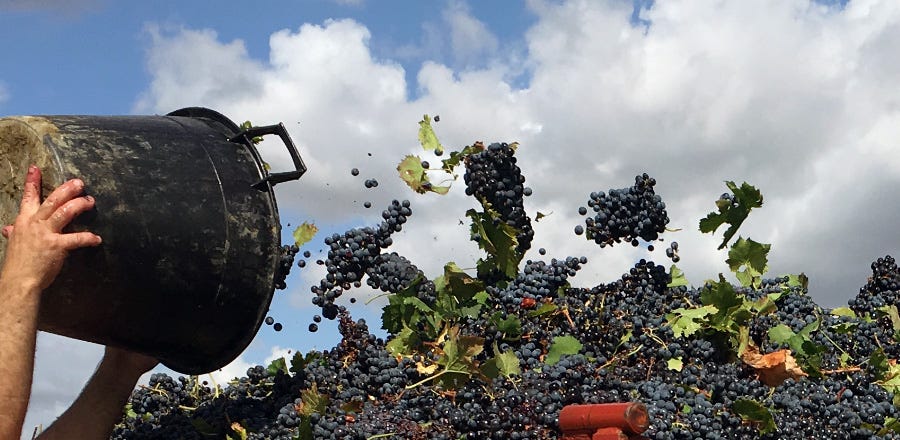
Keeping with our Italy theme this week, our Italian wine correspondent David Master returns with another dispatch, this time from Sicily. Frappato would be a perfect pairing with the stuffed pastas I wrote about the other day.
I’ve been thinking about something my Sicilian grandfather used to say: “There is nothing better than bread and butter.” As a kid, I didn’t totally understand what he was saying, but now I realize that he was talking about finding pleasure in simplicity. Lately, I’ve been feeling the same way about wine.
I’m getting sick of big, bold, overhyped, and overpriced prestige wines. Unaffordable and inconvenient. They are so damn needy. They need the right occasion, the right food, the right glass, the right lighting. Some even need to age for the right amount of time. For me, the pursuit of pricey, ageworthy, unicorn wines that demand overthinking has lost its luster. They are anything but simple.
Instead, I have turned to wines that are fun, food friendly, delicious—and, above all, affordable. Frappato, the Sicilian red grape, is one such wine—unfussy, unpretentious, so drinkable, and it’s got a ton of heart. It’s a grape for any occasion.
To love frappato is to love Sicily, its home. Sicily itself has earned the nickname of la scacchiera del mondo, or the chessboard of the world, since many cultures have ruled here at one point or another. Likewise, Sicily is chessboard of 24 appellations.
Said to be genetically linked to the sangiovese grape, frappato is primarily used as a blending agent in a number of the DOCs—including Alcamo, Eloro, Erice, and Vittoria. It is most commonly blended with bigger and bolder grapes such as nero d’avola, nerello mascalese, and nocera, where frappato brings finesse and elegance. For example, in Cerasuolo di Vittoria (Sicily’s only DOCG) the blend is always frappato (30-50%) and nero d’avola (50-70%).
These days, it’s becoming more common for frappato to be bottled as a single varietal wine, and many are bottled under the Terre Siciliane IGT designation, which has looser restrictions on winemaking style.
In dialect, the word frappato means fruttato, or fruity—a name that could not be more accurate. Typically coming in at 12 to 13 percent abv, frappato has soft tannins, its bouquet oozes notes of lavender and rose, it has a mouth-watering acidity, and most of all, it is refreshing. You can even serve it with a slight chill. It’s an easy-drinking red that can be paired with so many foods from sushi to shellfish to tomato-based pasta dishes to cured meats. Above all, frappato is the ultimate pizza wine. And to top it all off, it is modestly priced. It is rare to see a frappato for over $ 30, as most range from $ 15-$ 25. Frappato is truly an everyday wine, and joy to drink.
Though frappato is anything but fussy in the glass, this isn’t necessarily true for the vineyard. It needs a dry and warm climate, and soil with good drainage. Otherwise, it is susceptible to fungal disease. Sicily provides the perfect conditions for frappato to thrive, as it has mostly calcareous soils and its growing seasons are long, hot, and dry.
“Frappato is very different depending on where it is grown in Sicily,” says Ivan Gennuso, export manager for Gorghi Tondi. Frappato produced where Gorghi Tondi is located—on the southwestern coast in the province of Mazara del Vallo near Marsala—is light-bodied and transparent, fruit-forward and floral, with notes of black pepper and lavender. Gorghi Tondi is only meters away from the Mediterranean Sea, which has its influence on the wine, adding salinity and freshness. Frappato bottled here is labeled as Sicilia DOC, which only earned its status in 2011.
Moving to the southern tip of Sicily is the Vittoria DOC, which surrounds the more prestigious Cerasuolo di Vittoria DOCG. Wines from Cerasuolo di Vittoria wines are always a blend, but single-varietal frappato from Vittoria are typically darker and more extracted. They still have the same floral nose of lavender and rose, but with more herbal tones like sage and cured meat. Notes of cloves and cinnamon are common with these wines, as well as dried fruit. These frappato are age-worthy, and can benefit from five to ten years in the bottle. With time, the floral notes can turn peppery, and the fruit evolves with hints of tobacco and smoke.
Arianna Occhipinti is the world-renowned superstar of Vittoria. Her hand harvested, organically grown grapes are fermented with native yeasts, which go against the grain of typical Sicilian winemaking. She was initially inspired by her uncle Giusto, whose winery is COS and one Sicily’s most prominent producers. Her wines are biodynamic and fit the definition of “natural.” But at this point—like a lot of OG natural-wine pioneers—Occhipinti doesn’t refer to them as natural anymore. To her, that is just how wines should be made.
Winemakers who grow frappato ain’t in it for the money. Most of them get their bread and butter from higher selling reds, like nero d’avola or some of the better known international varieties. Frappato demands love from its growers since it does not have high yields, and it does not produce plentiful berries. Producers who make single variety wines from frappato are dedicated to championing this grape, and for some, the production of this wine is a labor of love. Frappato by nature is therefore the counterpoint to a global wine industry that is becoming evermore standardized and ubiquitous.
What gives a wine its value, what makes a wine special, is not its rarity or price tag, but its ability to be paired with the everyday moments of our lives. You can drink frappato while relaxing on a summer evening, catching up with an old friend, or with a good piece of crunchy bread topped with melted butter. Nothing can beat that.
Five No-Frills Frappato
Bottle recommendations and tasting notes are for paid subscribers only.


